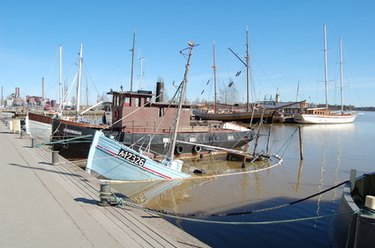
The nautical or shipping world has a wide range of terms specific to ships, and damaged and sinking ships are no exception. Terms may refer to the way in which a ship was damaged or how the ship sank. Knowing the basic terms for damaged and sinking ships can help you understand some of the dangers that ships face.
Overwhelmed
Video of the Day
A ship that is "overwhelmed" sinks because it cannot deal with the force of waves. An overwhelmed ship often becomes swamped, or has water coming in over the deck, before it sinks out of sight. An overwhelmed ship that sinks with its deck pointing upward has "foundered," while an overwhelmed ship that sinks on its side or with its hull, or bottom, pointing upward has "capsized."
Video of the Day
Break Deep
A damaged and sinking ship that "breaks deep" is one where the damage occurs to the ship below the water line. Often, a ship that breaks deep sinks when water rushes into the break and fills the ship. When this occurs, the ship is said to "take water." Often, the terms are used together. For instance, a sailor may say that a ship that filled and sank due to a hole in its side "broke deep and took water." A well-known ship that broke deep and took water was the H.M.S. Titanic, which ripped a hole in its side when it struck an iceberg in 1912.
Scuttle
To "scuttle" a ship is to sink the ship deliberately. When used as a noun, "scuttle" refers to a small opening in a ship's deck or hull, also known as a "seacock." The purpose of a seacock is to allow water to drain from the ship when it has been removed from the water for repairs. However, a ship may also be scuttled, or sunk, by opening the seacocks to allow water to flow in, similar to a ship that "breaks deep." A ship can also be scuttled by deliberately breaking holes in its sides. The primary difference between a ship that breaks deep and one that is scuttled is that breaking deep is an accident, while scuttling occurs deliberately.
Split Up
Particularly long ships such as those that haul metal ores are vulnerable to "splitting up" when the waves are high. A ship splits up when its front end, or bow, ends up on the crest of one wave, while the back end, or stern, ends up on the crest of the wave immediately behind it. The center of the ship is lifted out of the water and, with no support, may split in half, breaking the ship into two pieces that quickly founder or capsize. Splitting up is a particular danger on the Great Lakes, where the waves may be 30 feet or more in height but are very close together due to the relatively small size of the lakes compared with the ocean.
- S.S. Edmund Fitzgerald Online: FAQs
- Undergraduate Engineering Review: Causes and Effects of the Rapid Sinking of the Titanic
- Texas A&M University: French Nautical Glossary
- University of Chicago: Sinking Ship
- Princeton University: U.S. Navy Ship Classes
- Maharishi University of Management: Sailing Terms and Definitions